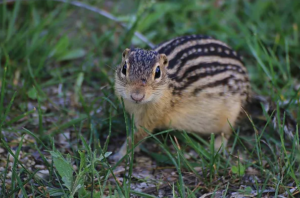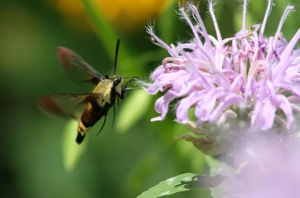Is Nature Relevant in Your Life
 It’s hot, and my clothing armor against the sun just makes it worse. I take a slow, deep breath through my nose, balancing my need for oxygen with the burning sensation of the humid air. I’m standing on an open sandstone ridge in a huge patch of blooming bergamot. Suddenly, a nearby spiderwort plant starts shaking wildly in the still air. I watch in fascination as a young thirteen-lined ground squirrel shimmies up the plant stalk to the seed head and rides it all the way down to the ground, claiming the bounty of seed. I pan my view out wider, and notice many other squirrels doing the same thing. I turn my attention next to the bumble bees, hoping that I might find a rare species. It’s good to be back to the familiar, I think.
It’s hot, and my clothing armor against the sun just makes it worse. I take a slow, deep breath through my nose, balancing my need for oxygen with the burning sensation of the humid air. I’m standing on an open sandstone ridge in a huge patch of blooming bergamot. Suddenly, a nearby spiderwort plant starts shaking wildly in the still air. I watch in fascination as a young thirteen-lined ground squirrel shimmies up the plant stalk to the seed head and rides it all the way down to the ground, claiming the bounty of seed. I pan my view out wider, and notice many other squirrels doing the same thing. I turn my attention next to the bumble bees, hoping that I might find a rare species. It’s good to be back to the familiar, I think.
I had spent the last four days in Orlando, Fla., visiting family. We stayed in a gated community of palm tree-lined streets, swimming pools and air conditioning. Judging by all the cars parked in driveways and along the streets, the neighborhood was packed. People from all over the country, I imagined, escaping to the land of Disney World and Universal Studios.
A bumble bee suddenly swoops in and lands on a bergamot flower next to me. I quickly focus the binoculars in time to watch, and hear, his whole body and wings vibrate wildly – buzz pollination. It’s a process used by some native bees to release stubborn pollen clinging to the flowers anthers. It’s why native bees are so critical for pollinating certain plant species, such as blueberries. The non-native honeybee, for example, cannot buzz pollinate. Two spots on its thorax identify it as a two-spotted bumble bee. A common species in southern Wisconsin.
On my first Florida morning, I set out on a stroll of the neighborhood’s extensive sidewalk system. No one was around other than the daily garbage crews collecting mounds of trash accumulated from the previous day’s festivities. The scenery was the same everywhere – identical houses with unique street address markers and a screened-in pool in the back, a splash of shrubs and ornamental grasses accented with pine-bark mulch tucked in near the front porch and concrete driveway. A ribbon of lawn separated each house, and another ribbon of lawn dotted with an occasional palm tree ran between the sidewalk and the street. My nature’s bounty from the stroll was several geckos, an unseen but noisy mockingbird in an overhead palm tree, and an unidentified fly-by bug.
 Another bumble bee lands nearby. It’s a big one with black wings. I sharply focus the binoculars. Yep, it’s a black and gold bumble bee, uncommon in Wisconsin. Without warning, a “large” critter fills my binocular’s field of view and my impulse to recoil is instantly diffused by my recognition of the species, a clearwing hummingbird moth. It flies just like a hummingbird, and it’s fascinating to watch. It’s another great example of a native pollinator with a unique anatomy allowing it to develop specialized relationships with certain plant species.
Another bumble bee lands nearby. It’s a big one with black wings. I sharply focus the binoculars. Yep, it’s a black and gold bumble bee, uncommon in Wisconsin. Without warning, a “large” critter fills my binocular’s field of view and my impulse to recoil is instantly diffused by my recognition of the species, a clearwing hummingbird moth. It flies just like a hummingbird, and it’s fascinating to watch. It’s another great example of a native pollinator with a unique anatomy allowing it to develop specialized relationships with certain plant species.
I tried an evening walk in our Florida neighborhood, hoping that the cover of darkness would bring out shy critters and the street lamps would attract nocturnal insects. Again, I came up short, spotting only a few moths fluttering around the street lights.
I can feel my pulse quickening, not from heat stroke but from the bumble bee that just arrived. Can it be, I think, as I struggle to get a close look at the brown patch under its wings. Come on, I think, lift those wings so I can see the patch. Finally, the bee cooperates, and I can see the brown patch is not surrounded by yellow. It’s a brown-belted bumble bee, common in Wisconsin. I was hoping it was an endangered rusty-patched bumble bee.
According to the U.S. Fish and Wildlife Service, the rusty-patched bumble bee is endangered because of habitat loss and degradation, intensive farming, disease, pesticides and global climate change. Nearly all of our prairies and grasslands have been converted to monoculture agriculture. The few that remain are degraded and isolated. The lack of plant diversity results in too few species blooming for only a short period of time. The extensive use of pesticides can harm bees through contact and accumulate in the soil putting ground-hibernating queen bees at risk. A changing climate puts more stresses on the bees such as queen bees emerging from hibernation and there are no flowers for food.
I chuckle at myself. Here I am, an hour after arriving home from Florida, and I’m out in the scorching sun looking at bumble bees. Clearly, I think, I needed to fill my nature void from the last four days. I pull my eyes away from the binoculars, and pause to expand on that thought. But why is nature important to me? My mind struggles, searching for words to describe what I feel and need.
I seek out nature because it’s true. Plants, animals and the ecological processes that connect it all together are real. When I participate in nature, I can trust what I see and feel. I feel accepted. I know I belong. Nature keeps me grounded to the basics of what matters in life. It’s a safe refuge to escape from the demands of our “engineered” society. The raw honesty of nature has never let me down.
But what about the neighborhood I left in Florida, or for any other similar neighborhood across the country? Do “normal” people feel a need to interact with nature? Do people seek out nature as an escape from our fast-paced life, or do they prefer to escape elsewhere, such as the world of Disney?
I ponder on this question. I’m too close to this, I think, my life is too wrapped up with nature to objectively answer this question.
I would love to hear from others.
Is nature relevant in your life?
Originally published in Environmental Returns.


